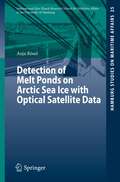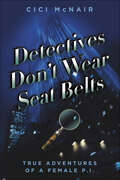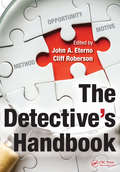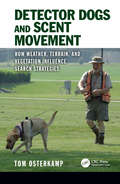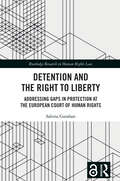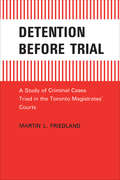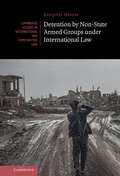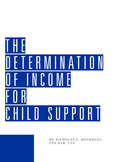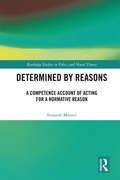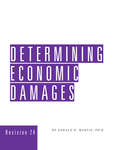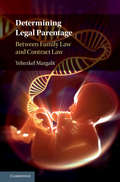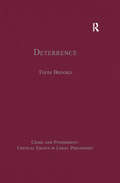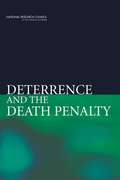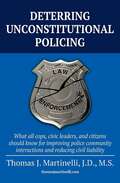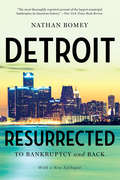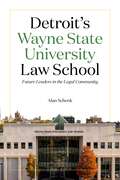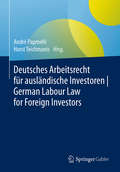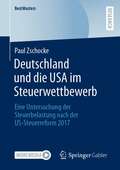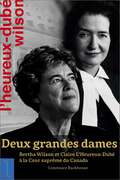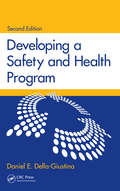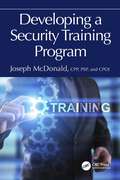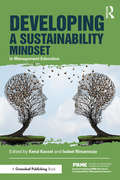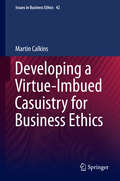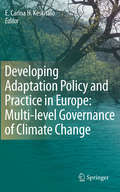- Table View
- List View
Detection of Melt Ponds on Arctic Sea Ice with Optical Satellite Data
by Anja RöselThe Arctic sea ice is characterized by profound changes caused by surface melting processes and the formation of melt ponds in summer. Melt ponds contribute to the ice-albedo feedback as they reduce the surface albedo of sea ice, and hence accelerate the decay of Arctic sea ice. To quantify the melting of the entire Arctic sea ice, satellite based observations are necessary. Due to different spectral properties of snow, ice, and water, theoretically, multi-spectral optical sensors are necessary for the analysis of these distinct surface types. This study demonstrates the potential of optical sensors to detect melt ponds on Arctic sea ice. For the first time, an Arctic-wide, multi-annual melt pond data set for the years 2000-2011 has been created and analyzed.
Detectives Don't Wear Seat Belts: True Adventures of a Female P.I.
by Cici McNairGrowing up in Mississippi, Cici McNair was always more the tomboy her mother supported than the Southern belle her father demanded. She escaped her suffocating upbringing the first chance she had to travel the world. Whether working at the Vatican in Rome or consorting with a gunrunner in Haiti, she lived a life of international adventure. When Cici finds herself in New York, divorced, broke, and fashionably starving to death in a Madison Avenue apartment, she impulsively decides to become a private detective.But, as Cici soon learns, the world of P.I.s is tight-knit and made up almost exclusively of former law enforcement officers. By nature, they are a highly suspicious group and are especially wary of a newcomer with an untraceable past. Diligently working her way through the Yellow Pages, doggedly pursuing the slightest lead, Cici is finally hired by a private investigator willing to take a chance. The next day she's working side by side with a pair of seasoned detectives and a skip tracer who is scary to meet but like silk on the phone. She quickly realizes she'll need all her energy and wits to succeed in this new world.Being a private investigator is as exciting and liberating as Cici ever dreamed, from creating a false identity on the spot on her first case in the field to surviving adrenaline-rushing car chases. Working with law enforcement, she goes undercover, dealing with the ruthless Born to Kill gang in Chinatown and the Middle Eastern counterfeiters west of Broadway. A detailed account of the hidden world and real-life cases of a P.I., this action-packed memoir is as entertaining as any detective novel you've ever read.
The Detective's Handbook
by Cliff Roberson John A. EternoThe Detective‘s Handbook details the vital information law enforcement officers need to know to become better detectives. Since all essential aspects of detective work cannot be covered in a single volume, the editors have selected 20 of the most critical issues detectives face in their day-to-day work and present them in separate chapters.Using a
Detector Dogs and Scent Movement: How Weather, Terrain, and Vegetation Influence Search Strategies
by Tom OsterkampDogs detect scent from a source that is carried to them in a plume by the wind. The most important tool for a detector dog handler to have on searches is a knowledge of scent plume movement or "scent dynamics" (the science of scent movement). Such knowledge resides primarily in scientific journals that are largely inaccessible to detector dog handlers and written in language that is difficult to understand. Detector Dogs and the Science of Scent Movement: A Handler’s Guide to Environments and Procedures retrieves, reviews, and interprets the results of pertinent scientific research on scent dynamics and presents these results in terms that are easier for handlers to understand. Information on the physiology of the dog’s nose, their sense of smell, and the properties of scent provide the essential information on the process of scenting. The composition of training aids for explosives, narcotics, human remains and other sources is discussed. Recommendations are made on the use of training aids, their placement during training, and the resulting availability of scent. Potential problems and handler errors in the use of training aids are also examined. The characteristics of scent plumes and how wind influences their movement are a key focus of the book. The primary task for the handler is to get the dog into the scent plume so that the dog can detect the scent and follow it to the source the handler seeks. As such, a knowledge of scent and scent plume movement will vastly improve the ability of the handler to accomplish this task. The influence of weather and physical settings such as terrain, vegetation, ground cover, soil and water on scent movement are examined in detail. Strategies for searching, detecting, and locating sources in all physical settings are presented. Specific effects associated with hills and mountains, fields and forests, bare soils and soils covered by vegetation, different soil types, and lakes and rivers are examined in detail. This includes specific recommendations are made about weather and physical settings that result in higher probability of success on searches. Detector Dogs and the Science of Scent Movement will be a vital resource for K9 handles in the private and public sectors—including in Homeland Security, law enforcement, and military settings—as well as a useful guide for lawyers, forensic, and investigative professionals who need to better understand K9 operations.
Detention and the Right to Liberty: Addressing Gaps in Protection at the European Court of Human Rights (Routledge Research in Human Rights Law)
by null Sabina GarahanThis book is a ground-breaking study of how the European Court of Human Rights interprets Article 5 of the European Convention on Human Rights – the right to liberty and security.The right to liberty is a fundamental provision that is enshrined not only in the Convention but in all major human rights treaties. Despite this, Article 5 remains both a largely underdeveloped and unexplored area of European human rights law. The work aims to fill this gap by presenting an original framework for the progressive interpretation of the right to liberty. It is argued that the Court has not made use of opportunities to evolve Article 5 standards, resulting in a weakening of protections against arbitrary detention. This book’s original framework for the progressive interpretation of Article 5 identifies and addresses gaps in the protection of vulnerable groups of detainees, including in areas of growing concern across the European human rights space. These include individuals held pre-trial, as children, in immigration detention, following protest, or as a result of their political dissent or human rights activism. The volume outlines the normative justifications for an evolutive approach to Article 5 and elaborates how a dynamic interpretation could be enacted in practice, including by reference to original interview data and insights from European Court of Human Rights judges.This book will serve as a key point of reference for anyone researching or working on detention and the right to liberty across the Council of Europe and beyond.The Open Access version of this book, available at http://www.taylorfrancis.com, has been made available under a Creative Commons Attribution (CC BY) 4.0 license
Detention Before Trial: A Study of Criminal Cases Tried in the Toronto Magistrates' Courts
by Martin L. FriedlandDetention before trial has been one of the most neglected areas in the whole administration of criminal justice. In the past, attention has been focussed almost exclusively on detention after trial (i.e. sentencing), which touches the lives of significantly fewer persons than detention before trial. There has been no previous examination in Canada of the utility or effectiveness of its operation. This study will fill an important need by documenting statistically the extent and nature of custody before trial in the Toronto Magistrates' Courts, where the overwhelming majority of citizens charged with criminal offences in the Toronto area are tried. Although the study is primarily directed at practices before trial in Toronto, many of these practices can be found in other cities throughout North America. Specific areas of importance which were investigated here include the use of the summons; the extent to which accused persons are detained in custody both before and after the first court appearance; bail-setting practices and the ability to raise bail; the activities of professional bondsmen; the enforcement of penalties for absconding; and the relationship between custody and the outcome of the trial. Much of the presentation of the data is descriptive, but attempts are made throughout the study to prove statistically the existence of casual relationships. The result is a work which brings together in lucid and scholarly form important evidence which will be valuable to lawyers and all who are professionally concerned with social problems, and of interest to everyone with a regard for the administration of justice.
Detention by Non-State Armed Groups under International Law (Cambridge Studies in International and Comparative Law #166)
by Ezequiel HeffesDuring armed conflict, non-State armed groups deprive individuals of their liberty. While this is not a new phenomenon, its pervasiveness is reflected by recent examples in Colombia, Libya, Syria, Ukraine, Mali and the Democratic Republic of the Congo. Yet, examining these activities goes beyond its mere acknowledgment. It involves questions concerning their legality and the non-State armed groups' motivations when depriving individuals of their liberty. Drawing on his personal experiences while working for various humanitarian organizations, Ezequiel Heffes aims at elucidating how international law can be used as a protective tool in relation to individuals placed in detention by non-State armed groups. Based on case studies of selected groups and a normative and doctrinal analysis, he proposes minimum humanitarian principles applicable to those situations. By addressing a contemporary issue that touches upon a number of legal regimes, this study makes a valuable contribution to the law applicable in armed conflict.
The Determination of Income for Child Support
by Nick BourdeauAccurate income figures are essential to child support calculations, but obtaining and agreeing upon true income can be a challenging process. Here is help. Nicholas Bourdeau's The Determination of Income for Child Support walks you line-by-line and issue-by-issue through the areas where income adjustments are most likely to be found. In this groundbreaking work, you receive: * Hard-won advice obtained from over 1,000 investigations. * Line-by-line guidance to Form 1040 and its supporting forms, annotated with common areas of dispute and what to investigate. * Detailed directions for questioning the deductions of self-employed individuals. * Tips for determining income when records are lacking. * Dozens of detailed illustrations highlighting common adjustments.
Determined by Reasons: A Competence Account of Acting for a Normative Reason (Routledge Studies in Ethics and Moral Theory)
by Susanne MantelThis book offers a new account of what it is to act for a normative reason. The first part of the book introduces some popular ideas and problems concerning causal and dispositional approaches of acting for reasons. The author argues that the dispositional approach should take a certain form that unites epistemic, volitional, and executional dispositions in a complex normative competence. This "Normative Competence Account" allows for more and less reflective ways of acting for normative reasons. The second part of the book clarifies the relation between the normative reason that an agent acts for and his or her motivating reasons. The chapters in this part refute the widely held "identity view" that acting for a normative reason requires the normative reason to be identical with a motivating reason. The author describes how normative reasons are related to motivating reasons by a relation of correspondence, and proposes a new understanding of how normative reasons explain those actions that are performed for them. Determined by Reasons engages with current debates from a wide range of different philosophical areas, including action theory, metaethics, moral psychology, epistemology, and ontology, to develop a new account of normative reasons.
Determining Economic Damages
by Gerald D. MartinThis toolbook is loaded with practical forms, procedures, tables, and tactics from two veteran economists who have consulted on thousands of cases. The explanations are thorough, the math is straightforward, and the advice is detailed and valuable. Whether or not your case justifies retaining an expert, Determining Economic Damages can guide you start-to-finish through damage assessment and proof: Determine past and future income losses. Compute the value of fringe benefits. Adjust for personal consumption. Adjust for income taxes. Measure the replacement value of household services. Compute life and worklife expectancy. Convert medical and rehabilitation reports into dollar values. Convert future losses to their present value. Put everything together to calculate loss. Prepare your case and expert for trial. Depose and cross-examine the opposing expert.
Determining Legal Parentage: Between Family Law and Contract Law
by Yehezkel MargalitThe last few decades have witnessed dramatic changes affecting the institutions of family and parenthood. If, in the past, the classic family was defined sociologically as a pair of heterosexual parents living together under one roof along with their children, different sociological changes have led to a rapid and extreme transformation in the definitions of family, marital relations, parenthood, and the relationship between parents and children. Dr Yehezkel Margalit explores whether and to what extent there is room, legally and ethically, for the use of modern contractual devices and doctrines to privately regulate the establishment of legal parentage. This book offers intentional parenthood as the most appropriate and flexible normative doctrine for resolving the dilemmas which have surfaced in the field of determining legal parentage. By using the certainty of contract law, determining the legal status of parenthood will be seen as the best method to sort out ambiguities and assure both parental and children rights.
Deterrence (Crime and Punishment: Critical Essays in Legal Philosophy)
by Thom BrooksDeterrence is a theory which claims that punishment is justified through preventing future crimes, and is one of the oldest and most powerful theories about punishment. The argument that punishment ought to secure crime reduction occupies a central place in criminal justice policy and is the site for much debate. Should the state deter offenders through the threat of punishment? What available evidence is there about the effectiveness of deterrence? Is deterrence even possible? This volume brings together the leading work on deterrence from the dominant international figures in the field. Deterrence is examined from various critical perspectives, including its diversity, relation with desert, the relation of deterrence with incapacitation and prevention, the role deterrence has played in debates over the death penalty, and deterrence and corporate crime.
Deterrence and the Death Penalty
by Daniel S. Nagin John V. Pepper Committee on Law and Justice Division of Behavioral and Social Sciences and Education Committee on Deterrence and the Death Penalty National Research CouncilMany studies during the past few decades have sought to determine whether the death penalty has any deterrent effect on homicide rates. Researchers have reached widely varying, even contradictory, conclusions. Some studies have concluded that the threat of capital punishment deters murders, saving large numbers of lives; other studies have concluded that executions actually increase homicides; still others, that executions have no effect on murder rates. Commentary among researchers, advocates, and policymakers on the scientific validity of the findings has sometimes been acrimonious. Against this backdrop, the National Research Council report Deterrence and the Death Penalty assesses whether the available evidence provides a scientific basis for answering questions of if and how the death penalty affects homicide rates. This new report from the Committee on Law and Justice concludes that research to date on the effect of capital punishment on homicide rates is not useful in determining whether the death penalty increases, decreases, or has no effect on these rates. The key question is whether capital punishment is less or more effective as a deterrent than alternative punishments, such as a life sentence without the possibility of parole. Yet none of the research that has been done accounted for the possible effect of noncapital punishments on homicide rates. The report recommends new avenues of research that may provide broader insight into any deterrent effects from both capital and noncapital punishments.
Deterring Unconstitutional Policing: What All Cops, Civic Leaders, and Citizens Should Know for Improving Police Community Interactions and Reducing Civil Liability
by Thomas J. MartinelliAs punctuated through recent events, societal perceptions are that American policing continues to fail in its mission, to protect and preserve. Whether because of institutionalized prejudices that emphasize an "us versus them" mentality, reinforced through warrior training tactics, or poor recruiting, training, leadership and discipline, or a combination of these factors, the police profession continues to be challenged in its mission to deliver police services to the very citizens they swore to serve. <p><p> The challenge now is to recognize the profession's shortcomings regarding indifference, negligence, intentional acts and their cover-ups and the costs associated with such unconstitutional policing tactics. We must all learn from them, police and citizens alike, to better police service and citizen expectations. These are preventable, compensable acts of liability that are the direct result of inadequate legal training, poor supervision, dysfunctional police organizations and occupational prejudices against the disenfranchised, the marginalized and the less fortunate. <p><p> The profession must focus on comprehensively training the next generation of officers regarding these breaches of duty that dilute the public's trust in their law enforcement. As well, civic leaders and citizens must appreciate what and how costly unconstitutional police acts are and hold their agencies accountable for such malpractice. Such acts taint the profession, tarnish the public's perceptions, cost taxpayers exponentially in jury awards and settlements and deplete a department's morale. <p><p> Noble integrity is a training concept that defines and refines the balance between the constitutional limitations of badge authority with the guardian/warrior mindset, demonstrated through an oath-based training approach. It exemplifies the Intelligence Led Policing philosophies of self-policing, Unit policing, whisteblowing, audits and purges and hierarchical accountability. By referencing U.S. Supreme Court cases the reader is better educated in the nuances and standards of constitutional police procedures, coupled with police malpractice incidents that have cost officers their jobs, department's the public's trust and municipalities in crippling legal fees. "Doing the noble thing" must be the standard and mantra for 21st century policing to begin the police-community healing. But it is the police profession that must begin this healing process in changing its officers' mindset. <p><p> The challenge today is enlightening, thus empowering, all students of policing as to the legal and ethical standards our police officers must be held to in order to improve police-community relations and reduce municipal civil liability. This includes, but is not limited to discussions regarding Constitutional Law, Qualified Immunity, De-escalation measures, Violations of the Oath of Office, the temptations of the profession and national de-certification indexes. Quality of character matters in all facets of policing and is a defense to allegations of police malpractice and breaches of the oath.
Detroit Resurrected: To Bankruptcy And Back
by Nathan BomeyWhat happens when an iconic American city goes broke? At exactly 4:06 p.m. on July 18, 2013, the city of Detroit filed for bankruptcy. It was the largest municipal bankruptcy in American history--the Motor City had finally hit rock bottom. But what led to that fateful day, and how did the city survive the perilous months that followed? In Detroit Resurrected, Nathan Bomey delivers the inside story of the fight to save Detroit against impossible odds. Bomey, who covered the bankruptcy for the Detroit Free Press, provides a gripping account of the tremendous clash between lawyers, judges, bankers, union leaders, politicians, philanthropists, and the people of Detroit themselves. The battle to rescue this iconic city pulled together those who believed in its future--despite their differences. Help came in the form of Republican governor Rick Snyder, a technocrat who famously called himself "one tough nerd"; emergency manager Kevyn Orr, a sharp-shooting lawyer and "yellow-dog Democrat"; and judges Steven Rhodes and Gerald Rosen, the key architects of the grand bargain that would give the city a second chance at life. Detroit had a long way to go. Facing a legacy of broken promises, the city had to seek unprecedented sacrifices from retirees and union leaders, who fought for their pensions and benefits. It had to confront the consequences of years of municipal corruption while warding off Wall Street bond insurers who demanded their money back. And it had to consider liquidating the Detroit Institute of Arts, whose world-class collection became an object of desire for the city's numerous creditors. In a tight, suspenseful narrative, Detroit Resurrected reveals the tricky path to rescuing the city from $18 billion in debt and giving new hope to its citizens. Based on hundreds of exclusive interviews, insider sources, and thousands of records, Detroit Resurrected gives a sweeping account of financial ruin, backroom intrigue, and political rebirth in the struggle to reinvent one of America's iconic cities.
Detroit's Wayne State University Law School: Future Leaders in the Legal Community (Great Lakes Books Series)
by Alan SchenkMost histories of law schools focus on the notable deans and professors, and the changes in curricula over time. In Detroit’s Wayne State University Law School: Future Leaders in the Legal Community, Alan Schenk highlights the students and their influence on the school’s development, character, and employment opportunities. Detroit’s Wayne State University Law School begins by placing the school in historical context. Public law schools in major American cities were rare in the 1920s. WSU Law School started as a night-only school on the brink of the Great Depression. It was administered by the Detroit Board of Education’s Colleges of the City of Detroit and was minimally funded out of student tuition and fees. From its opening days, the school admitted students who had the required college credits, without regard to their gender, race, or ethnic backgrounds, when many law schools restricted or denied admission to women, people of color, and Jewish applicants. The school maintained its steadfast commitment to a racially and gender-diverse student body, though it endured significant challenges along the way. Denied employment at selective law firms and relegated to providing basic legal services, WSU law students pressed the school to expand the curriculum and establish programs that provided them with the credentials afforded graduates from elite law schools. It took the persistence of the students and a persuasive dean to change the conversation about the quality of the graduates and for law firms representing the largest corporations and wealthiest individuals to start hiring WSU graduates who now heavily populate those firms. In the twenty-first century, the school gained strength in international legal studies and established two law centers that reflect the institution’s longstanding commitment to public interest and civil rights. While much of the material was gathered from university and law school archives, valuable information was derived from the author’s recorded interviews with alumni, deans, and professors. This book will strike the hearts of WSU law school students and alumni, as well as those interested in urban legal education and history.
Deutsches Arbeitsrecht für ausländische Investoren | German Labour Law for Foreign Investors
by André Papmehl Horst TeichmanisDieses zweisprachige Praxisbuch bewahrt internationale Investoren vor unangenehmen Überraschungen im deutschen Arbeits- und Sozialrecht. Es vermittelt einen fokussierten Überblick über die wesentlichen Regelungen sowie Einblicke in die kulturellen Rahmenbedingungen. Erfahrene Praktiker beleuchten wichtige Aspekte und zeigen sehr praxisorientiert, worauf es ankommt: Eine wertvolle Hilfe für alle, die mit deutschen Unternehmen zusammenarbeiten oder in Deutschland investieren wollen.This bilingual publication protects international investors from unpleasant surprises in respect to German employment and social security law. It provides a focused overview of the key provisions as well as insights into the underlying cultural conditions. Experienced practitioners explain many important aspects and illustrate what really matters in the real world: an invaluable aid to everyone working with German companies or aiming to invest in Germany.
Deutschland und die USA im Steuerwettbewerb: Eine Untersuchung der Steuerbelastung nach der US-Steuerreform 2017 (BestMasters)
by Paul ZschockeMit dem Inkrafttreten des Tax Cuts and Jobs Act zum 01.01.2018 haben die USA die größte Reform ihres Steuerrechts seit der Regierung Ronald Reagans unternommen. Die größte Bedeutung wird dabei der deutlichen Herabsetzung des US-Körperschaftssteuersatzes beigemessen. In der Folge kam es in Deutschland ebenso zu einer Diskussion darum, ob eine Senkung des deutschen Körperschaftssteuersatzes durch den internationalen Steuerwettbewerb notwendig ist. Das vorliegende Buch setzt sich mit dieser Forderung auseinander und untersucht die Steuerbelastung deutscher und US-amerikanischer Kapitalgesellschaften mit natürlichen Personen als Gesellschafter vor und nach der US-Steuerreform 2017 in einem dynamischen Modell.
Deutschland zwischen europäischer Integration und Souveränismus – La Germania tra integrazione europea e sovranismo: Konstitutionalismus 100 Jahre nach der Weimarer Verfassung und seit 70 Jahren Grundgesetz – Il Costituzionalismo a 100 anni dalla costituzione di Weimar e a 70 dalla Legge fondamentale
by Giuseppe Franco Ferrari Sandro Mario MoraldoDie Weimarer Reichsverfassung ist ein Eckpfeiler des Konstitutionalismus des 20. Jahrhunderts. Die italienische Charta aus dem Jahr 1948 und das deutsche Grundgesetz aus dem Jahr 1949 repräsentieren den Verfassungszyklus nach dem Zweiten Weltkrieg. In diesem Band feiern italienische und deutsche Wissenschaftler das 100-jährige Jubiläum von Weimar und das 70-jährige des Grundgesetzes in einem Vergleich publizistischer Kulturen. La Costituzione di Weimar è un caposaldo del costituzionalismo del '900. La Carta italiana del 1948 e la Legge fondamentale tedesca del 1949 rappresentano il ciclo costituzionale del secondo dopoguerra. In questo volume studiosi italiani e tedeschi celebrano i 100 anni di Weimar ed i 70 del Grundgesetz in un confronto di culture pubblicistiche.
Deux grandes dames: Bertha Wilson et Claire L’Heureux-Dubé à la Cour suprême du Canada (Biographies et mémoires)
by Constance BackhouseBertha Wilson et Claire L’Heureux-Dubé ont été les premières femmes juges à la Cour suprême du Canada. L’une représentait le Canada anglais, l’autre le Québec. De milieux et de tempéraments opposés, les deux femmes ont affronté des défis similaires. Leurs nominations judiciaires dans les années 1980 ont ravi les féministes et bousculé l’establishment juridique.Constance Backhouse plonge ici au cœur des obstacles sexistes que les deux femmes ont affrontés en éducation, en pratique du droit et dans les cours de justice. Elle explore les divers moyens que celles-ci ont utilisés pour les surmonter, de même que les décisions marquantes qu’elles ont prises pour défendre les droits des femmes et leur traitement mitigé de la question raciale.Explorer les vies et les carrières de ces deux pionnières, c’est s’aventurer dans un monde de sexisme légal appartenant à une époque passée. Quand L’Heureux-Dubé a voulu s’inscrire à la Faculté de droit de l’Université Laval (défiant ainsi son père), un fonctionnaire de l’université lui a répondu que le droit était une discipline « réservée aux hommes ». Quand Bertha Wilson est entrée à la Faculté de droit de Dalhousie University, le doyen lui a suggéré de « retourner à la maison et se mettre au crochet ».Rappeler leurs efforts que ces deux femmes ont déployés pour naviguer dans une tempête de sexisme révèle les fondements des inégalités de genre dans notre passé. La question est maintenant : quelle part de ce sexisme a été relégué aux poubelles de l’histoire et quelle part continue de nous hanter ?Bertha Wilson and Claire L’Heureux-Dubé were the first women judges on the Supreme Court of Canada. One represented English Canada, the other Quebec. Polar opposites in background and temperament, the two faced similar challenges. Their 1980s judicial appointments delighted feminists and shocked the legal establishment. Constance Backhouse delves into the sexist roadblocks both women had to face in education, law practice, and in the courts. She explores their different ways of coping, their landmark decisions for women’s rights, and their less than stellar records on race.To explore the lives and careers of these two path-breaking women is to venture into a world of legal sexism from a past era. When L’Heureux-Dubé sought to enroll at Laval law school (over her father’s vehement objection), a university official told her law was “only for men.” When Bertha Wilson entered Dalhousie Law School, the Dean suggested she “go home and take up crocheting.” Tracing their efforts to navigate a storm of sexism tells much about the roots of gender inequality from our past. The question becomes, how much of that sexism has been relegated to the bins of history, and how much continues to haunt us?Published in French.
Developing a Safety and Health Program
by Daniel E. Della-GiustinaReflecting changes in the field during the ten years since the publication of the first edition, Developing a Safety and Health Program, Second Edition examines the elements of a safety and health program and delineates how to incorporate them into an organization's safety efforts. It begins by defining safety policy and providing an overview of OS
Developing a Security Training Program
by Joseph McDonaldDeveloping a Security Training Program focuses on how to establish a comprehensive training program for a security department from the ground up. This book highlights formal curriculum development, consistent and continual training, and the organizational benefits including how such security training will be a value-add.It’s long overdue for the industry to revisit old security training models from the past — to both general staff as well as to the dedicated security staff and professionals within organizations — and examine and revamp such with a fresh perspective. Given the current, dynamic environment for businesses — and the threats businesses face — it is important that any such training consider all procedures and policies, and be fully integrated into the company culture. This includes maintaining an eye on budgetary and financial costs while recognizing the need to budget for more training resources to maintain resilience and adaptability to current challenges and future changes to the environment. There is only one way to prepare your staff and that is through comprehensive and consistent training.Developing a Security Training Program provides the blueprint and tools for professionals to provide ongoing, targeted, and comprehensive security training at a low, budget-friendly cost.
Developing a Sustainability Mindset in Management Education (The Principles for Responsible Management Education Series)
by Kerul Kassel Isabel RimanoczyWith an expanding awareness of the challenges of sustainability, featured more in the daily news than in higher education textbooks, scholars and faculty have been called to connect their syllabi to the ‘real world’. This book doesn’t just offer the ‘why’; it offers the ‘how’ through presenting the definition and model of the ‘sustainability mindset’ to help educators frame curricula to facilitate broad and deep systemic learning among current and future leaders. A sustainability mindset is intended to help individuals analyze complex management challenges and generate truly innovative solutions. The sustainability mindset breaks away from traditional management disciplinary silos by integrating management ethics, entrepreneurship, environmental studies, systems thinking, self-awareness and spirituality within the dimensional contexts of thinking (knowledge), being (values) and doing (competency). This book is aimed at professors, faculty members, instructors, teaching assistants, researchers and doctoral students in higher learning management education programs. Chapter contributors are all teaching professionals from programs around the world, who have been doing research and creating curricula, assessments, tools, and more for the students in their classes, and the book will be globally applicable.
Developing a Virtue-Imbued Casuistry for Business Ethics
by Martin CalkinsCasuistry, Virtue and Business Ethics brings together three important processes for business ethics: casuistry, virtue ethics and the business case method. In doing so, it considers the overlap and synergy of casuistry and virtue ethics, the similarities and differences of casuistry and the business case method and the relationships between emerging and well-established cases. The goal of the book is twofold: to provide a distinctly practical method for moral decision-making within the context of business and to illustrate how contemporary vexing issues are similar to those of the past and how they might be resolved satisfactorily.
Developing Adaptation Policy and Practice in Europe: Multi-level Governance of Climate Change
by E. Carina KeskitaloMitigation will not be sufficient for us to avoid climate change and we will need to adapt to its consequences. This book targets the development of adaptation policy in European countries with different relations between central and regional/local government.
